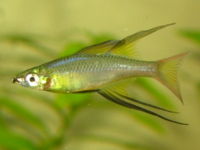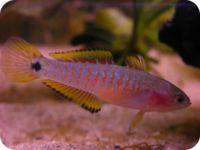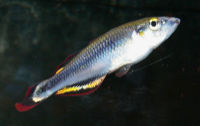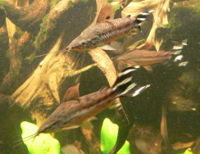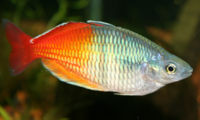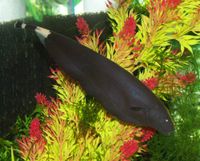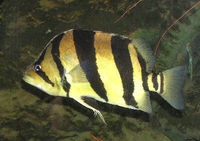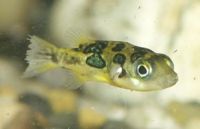Stocking an Oddball Tank
Contents
What is an Oddball tank?[edit]
Oddballs are fish that do not necessarily fall directly into the more common categories of shoaling or community fish. Most have very unique characteristics and habits. Some will work in the average community tank with careful consideration, others may be very delicate or highly predatory and therefore only suitable for species tanks. Oddballs come in every shape and size, see the article below with regards to just some you can consider for your tanks.
All oddballs listed here are for freshwater only and tank sizes start at 57 Litres (15 US G.). If your tank is smaller please see our Stocking a 10 Gallon Tank article. It should also be considered that all tank sizes are long rectangular tanks, not tall tanks unless otherwise stated.
Useful Links[edit]
Oddballs for a Community Tank[edit]
The following fish may be suitable for community tanks, read carefully as they still do have very specific needs and may, for example, not be able to be housed with larger fish as they may be eaten, or visa versa!
As with our other "Stocking" articles, the following fish are ordered by tank volume, of course those suitable for smaller volumes would still like larger volumes, but not the other way round!
57 Litres (15 US G.) plus[edit]
- Threadfin Rainbowfish (Iriatherina werneri)
An interesting alternative to more well known shoaling fish. The Threadfin is very distinctive to look at and entirely peaceful. It's best to keep 1 male to 2-3 females, more than one male to a tank is advisable as this is when they show their best colours as they show off towards each other. They shouldn't fight. Due to their long fins it's best they're not kept with anything that may even slightly nip such as Tetras.
- Dwarf Pencilfish (Nannostomus marginatus)
The Dwarf Pencilfish is small and peaceful and an interesting alternative to Tetras. It's not strictly shoaling but does better with others of it's own kind, keep in groups of at least 3-4 or more and be prepared to separate them if any become overly dominant. They are tiny and shouldn't be kept with much larger or boisterous fish as they may be bullied or eaten.
- Clown Killifish (Pseudepiplatys annulatus)
A gorgeous but tiny Killifish which get 3.8cm (1.5"), Clowns shouldn't be kept with larger species. They have striking banding patterns and popular for smaller tanks. They can be sensitive to water chemistry so best in a mature planted aquariums.
- Peacock Gudgeon (Tateurndina ocellicauda)
A small and not overly active Gudgeon, a trio would work well in this size tank (one male and two females). This fish is primarily mid-bottom dwelling and would do best with slow-swimming peaceful mid-top dwellers such as smaller Rasboras and Threadfin Rainbowfish. These fish may need to be target fed however as they are not quick to find food. The do not do well with a lot of current in the tank and prefer a soft sandy substrate and plenty of places to hide.
- Bumblebee Goby (Brachygobius genus)
These are very tiny but curious little Gobys. There is some debate on whether they should really be kept in freshwater or only in brackish, indeed many have had success with both. The main thing to remember with these little guys is to not keep them with anything that can eat them! They are also known to fin nip, so are best kept with short-finned fish and will tolerate their own kind but can be territorial so space and hiding places should be provided.
- Freshwater Neon Goby (Stiphodon atropurpureus)
A curious small Goby that can tolerate both freshwater and brackish also. It is an active algae grazer and therefore must be kept in a mature tank with algae growth, albeit they will only eat soft short algae, they will not eat filamentous algae. They should also accept blanched veges or sinking algae wafers. They are peaceful but territorial towards other Gobies. Male/female pairs should work. They appreciate a good current and rounded river rock décor as well as places to hide as they can be quite shy. Should not be kept with boisterous tank mates.
- Marbled Hatchetfish (Carnegiella strigata strigata)
A popular peaceful unusual looking shoaling fish which should be kept in a group of at least 6. This species gets about 5.1cm (2") and other species such as the Pygmy Hatchetfish and Silver Hatchetfish may also be seen for sale. These fish are almost entirely top dwelling and must be kept in a tank with a secure lid, they will jump!
- Norman's Lampeye (Poropanchax normani)
A popular small community fish, best kept with similar micro species. They get 3.2cm (1.25") and have a bright blue spot above their eyes that glimmers and shines as they swim, they look stunning a group. Can be sensitive to water chemistry so best in a mature tank.
114 Litres (30 US G.) plus[edit]
- Dwarf Chameleon Fish (Badis badis)
These fish reach around 7.6cm (3") and while at first being shy, soon become far more outgoing and should therefore never be housed with shy fish, smaller fish nor anything long-finned. It should be perfectly fine housed with similar sized fish such as larger Danios. Décor should consist of tall planting and plenty of caves as well as subdued lighting. They do best in male/female pairs ideally, two males may well fight.
- Madagascan Rainbowfish (Bedotia geayi)
These are peaceful shoaling fish that should be kept in groups of 5 or more (depending on overall tank size). Keep more females than males. They reach around 8.9cm (3.5") in length and should be kept with similar sized peaceful fish. It would be best to avoid anything with long fins or anything aggressive with these Rainbowfish.
- Glass Catfish (Kryptopterus bicirrhis)
An interesting fish with an entirely transparent body. This catfish gets approximately 3-6" (7.6-15.2 cm) in length so requires a spacious tank. They can be pretty shy so must be in groups of at least 4-5 or more. They should cohabit peacefully with similar sized peaceful fish, but will be bullied by more boisterous fish. Does not cope in strong currents or very bright lighting, does best in densely planted mature tanks.
- Indian Glassfish (Parambassis ranga)
Another fish species with a transparent body, although care must be made as these fish are often dyed fish victims. The Indian Glassfish is an active shoaling fish that should be kept in groups of 6 or more. They are generally peaceful and happy to be kept in community set ups with similar sized calm robust fish species, they do not do well in a frantic community set up. The males can be territorial and chase each other around, but this rarely results in any injury. They shouldn't be kept with long-finned fish as they may fin nip.
- Flag-Tailed Catfish (Dianema urostriatum)
An attractive species of catfish which isn't often seen for sale. They get a good size, up to about 12.7cm (5"), and are best kept in a group of at least 5. They should not be kept with aggressive tank mates and thrive in a peaceful set up with similar sized tank mates. They do best on a sandy substrate with lots of hiding places.
- Leaf Fish (Monocirrhus polyacanthus)
A very unusual looking fish with excellent camouflage designed to make it look like a dead leaf floating in the water. This fish is a predator so should not be kept with small fish as they will be eaten. This fish gets around 7.6cm (3") and does best with peaceful bottom dwelling fish as it doesn't like being pestered.
208 Litres (55 US G.) plus[edit]
- Boesemani Rainbowfish (Melanotaenia boesemani)
A very colourful larger Rainbowfish that reaches around 12.7cm (5"). These are sociable fish and are best in groups, with more females per males, but keeping several males will result in the best colour displays. They shouldn't be kept with much smaller fish nor with very long-finned fish. They are active mid-swimming fish that do well in planted tanks with open swimming space.
- Ropefish (Erpetoichthys calabaricus)
An unusual looking fish, indeed the only species in its genus and a cousin of the Bichir. The Ropefish is a nocturnal predator so must be kept with peaceful yet robust mid-top dwellers who are fast swimming and larger than the Ropefish. Smaller fish will be eaten. Their tank must be secure as these are well known escape artists! Provide them with a soft substrate and places to hide. They are not aggressive towards their own kind and do well in groups. In captivity they usually get to around 30.5cm (12"), maybe more, but in the wild they can reach in excess of 76.2cm (30")!!
- African Knifefish (Xenomystus nigri)
One of the smaller Knifefish available, the African Knifefish is a nocturnal predator and its really best to keep one to a tank. They are a threat to small fish, but entirely peaceful towards larger fish. Keep with other peaceful larger fish such as Rainbowfish. They are sensitive to water quality so need mature tanks and plenty of hiding places.
- Zig-Zag Eel (Mastacembelus circumcinctus)
A nocturnal Spiny Eel, the Zig-Zag is one of the smaller species. It is suitable with other fish as long as they're not small enough to eat, which rules out any fish 5.1cm (2") and under. Would be fine with larger robust fish such as Giant Danios or Boesemani Rainbowfish. It also does not mind its own species. They are burrowing fish so decor must be stable and substrate must be soft. They are also nocturnal so benefit from caves and tunnels in which to hide.
- Pinktailed Chalceus (Chalceus macrolepidotus)
A handsome chunky Characin that gets 20.3-22.9cm (8-9"), these guys are predatory so absolutely cannot be kept with bitesize tank mates! Can only be kept with robust similar sized fish. Can be kept with its own kind, but only in large groups of 8 or more to prevent bullying, or kept singly. Best in a large laterally spacious tank as they are active fish.
284 Litres (75 US G.) plus[edit]
- Black Ghost Knifefish (Apteronotus albifrons)
These are popular and the most commonly seen of the Knifefish and sold when quite small. Don't let that fool you. These guys should get at least 30.5cm (12"), in the wild they reach closer to 50.8cm (20")! They are nocturnal predators but have quite a small mouth and are peaceful towards larger tank mates, do not keep with fish 5.1cm (2") and under. They can also be quite shy so should not be kept with boisterous fish nor with suckermouth fish which may suck on the Knifefish's flanks. It is recommend that one BGK is kept to a tank, as they will bully and dominate one another. They should work fine in a spacious tank with plenty of hiding places with tank mates such as medium sized peaceful South American Cichlids such as Blue Acaras or larger peaceful Characins.
- Fire Eel (Mastacembelus erythrotaenia)
A popular and stunning looking eel-like fish. This fish gets quite large, usually around 30.5-61cm (12-24") in captivity but can get over 76.2cm (30") in the wild! It is also a predator and should therefore only be housed with larger robust yet peaceful mid-top dwelling fish, smaller fish will be eaten. They often will not tolerate others of their own kind or similar species as they mature however. They should be provided with hiding places - PVC pipe is popular with these fish.
- False Siamese Tigerfish (Datnioides microlepis)
An attractive fish with bold vertical banding. It's only suitable for larger set ups and should either be kept singly or in groups of 5 or more. In smaller groups they are prone to aggression issues. Should not bother fish too large to be eaten, that being they should either match the False Tigerfish in size or be larger, yet robust and relatively peaceful.
- Rainbow Snakehead (Channa bleheri)
One of the smaller of the Snakehead species. The Rainbow Snakehead works well in a community tank with larger robust species, it must be noted that smaller fish may well become food! It won't be very tolerating towards other Snakeheads either. You must make sure you have a secure tank if you consider one of these as they are excellent escape artists!
- Flagtail Characin (Semaprochilodus insignis or Semaprochilodus taeniurus)
A striking large Characin, there are two very similar species that may be sold under the same name. They can be aggressive towards their own kind if not kept in numbers, so should either be kept singly or in a group of 6 or more. As these fish get up to 35.6cm (14"), a group would need a very large tank. They are active swimming fish so need a tank at least 6' (1.8m) long. They are vegetarian and can be kept with similar sized fish.
- Black Banded Leporinus (Leporinus fasciatus)
A large striking banded fish which gets up to 30.5cm (12") in size. They are active and should only be kept with robust similar sized tank mates, they can fin nip despite being primarily vegetarian. Can be kept in groups of its own kind as long as the tank is very spacious.
Oddballs for a Species Tank[edit]
The following fish do not play well with others. Some may tolerate their own kind, others are simply too aggressive or predatory to be kept with anything else.
57 Litres (15 US G.) plus[edit]
- Dwarf Puffer (Carinotetraodon travancoricus)
A tiny (1" long) puffer fish that thrives in 38 Litres (10 US G.) or larger. These curious little fish are also exceptionally aggressive. In a tank the décor should feature dense planting, caves and bogwood. These fish are very curious and need to be kept busy. In terms of stocking, two males should not be kept as they will fight to the death. It's generally recommended to keep 8-11 Litres (2-3 US G.) per fish, so therefore in a 57 Litres (15 US G.), you can keep 3 females and 1 male. Or 4 females.
114 Litres (30 US G.) plus[edit]
- Congo Pufferfish (Tetraodon miurus)
An unusual predatory pufferfish that does best in its own tank or possibly with fast swimming top dwellers. Anything that lingers too close will be nipped, this may include you if you're too slow during tank maintenance! They must be kept on a deep sandy substrate as they love to burrow, so it needs to be as deep as the fish is long. See a video of the fish burrowing on its species page. They get up to 15.2cm (6").
208 Litres (55 US G.) plus[edit]
- Bucktoothed Tetra (Exodon paradoxus)
A very feisty species of Tetra which gets up to 15.2cm (6"). They are active and should be kept in groups of at least 8-10 or more in a long tank. While tank mates aren't completely out the question, these guys will pester and fin nip even the toughest of tank mates. Must also be kept in a tank with a secure lid or they will end up on the floor.
284 Litres (75 US G.) plus[edit]
- Tiger Tetra (Hoplias malabaricus)
This is a large growing predatory fish in the Erythrinidae family. It has an impressive set of teeth and won't think anything of taking a lump out of tank mates! For this reason it's best to keep one of these fish to a tank, alone. It requires some secure décor as they will appreciate hiding places. Its not a very active fish, except at feeding time.
Oddballs to Avoid[edit]
The following fish are best avoided unless you have very large aquaria, a bucket full of cash and a ton of patience! Many of these fish are also irritatingly common as juveniles in pet stores, buyer beware!
- Mbu Puffer (Tetraodon mbu)
A very very large Puffer often seen on sale when it's around the 15.2cm (6") mark. This fish should get around 61-73.7cm (24-29") long and be exceptionally messy with that. They are not suitable for any kind of community setting and will nip at and eat other fish. They do have excellent personalities and are rewarding if you are capable of housing something that needs a very long and wide tank just to itself!
- Silver Arowana (Osteoglossum bicirrhosum)
The most common of all Arowana found on sale, and also the largest topping out at around 61-76.2cm (24-30"). They need very long and wide tanks as they have a large turning circle and suffer from disorders such as drop eye and gill curl if not cared for properly. These fish really need large tropical ponds and can be kept with similar sized peaceful yet robust mid-bottom dwelling fish, the Arowana is almost entirely top dwelling and perfectly capable of smashing through a flimsy tank lid! They will also eat smaller tank mates.
- Clown Knifefish (Chitala chitala)
This fish is often seen in pet stores when anything from 7.6-10.2cm (3-4") to 30.5cm (12"), but, sadly, that's still only barely half-grown. These are very large Knifefish that need a large turning circle and therefore best only to be kept in large tropical ponds. They should eventually get around 88.9-121.9cm (35-48")!!
- Vampire Tetra (Hydrolycus scomberoides)
A very distinctive and striking fish, but also gets very large, up to 76.2cm (30") and requires a long, very very well filtered tank with a strong current to thrive. Not for novice keepers.
